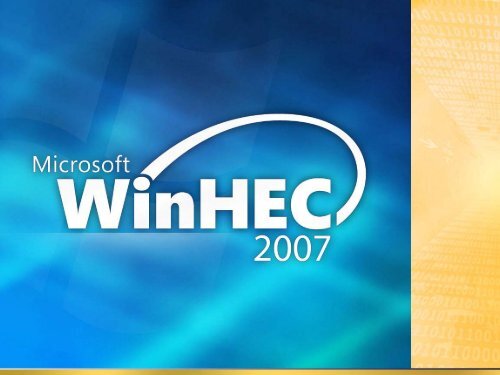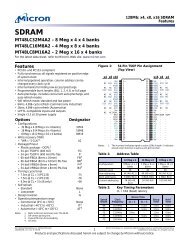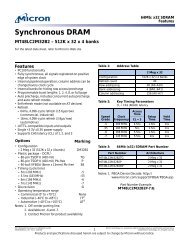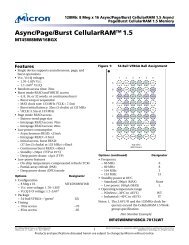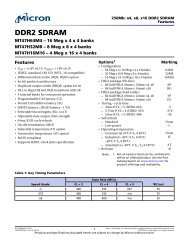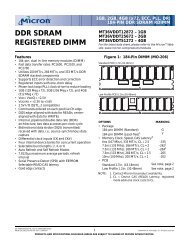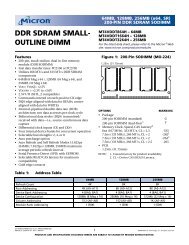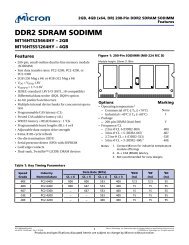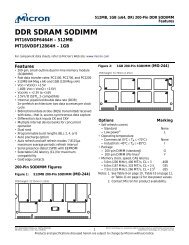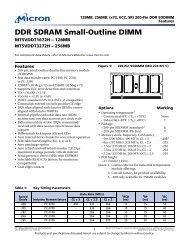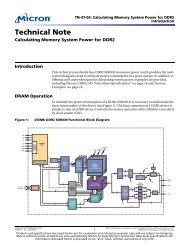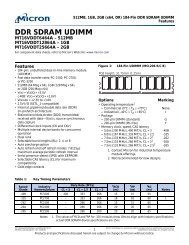Main Memory Technology Direction - Micron
Main Memory Technology Direction - Micron
Main Memory Technology Direction - Micron
You also want an ePaper? Increase the reach of your titles
YUMPU automatically turns print PDFs into web optimized ePapers that Google loves.
<strong>Main</strong> <strong>Memory</strong> <strong>Technology</strong><br />
<strong>Direction</strong><br />
Kevin Kilbuck<br />
Senior Segment Marketing Manager<br />
Computing and Servers<br />
<strong>Micron</strong> <strong>Technology</strong>, Inc.<br />
©2007 <strong>Micron</strong> <strong>Technology</strong>, Inc. All rights reserved. Products are warranted only to meet <strong>Micron</strong>’s production data sheet specifications. Information, products<br />
and/or specifications are subject to change without notice. All information is provided on an “AS IS” basis without warranties of any kind. Dates are estimates<br />
only. Drawings not to scale. <strong>Micron</strong> and the <strong>Micron</strong> logo are trademarks of <strong>Micron</strong> <strong>Technology</strong>, Inc. All other trademarks are the property of their respective<br />
owners.
Agenda<br />
DRAM <strong>Technology</strong> Trends<br />
Computing Customer Requirements<br />
Introduction to DDR3
DRAM <strong>Technology</strong><br />
Trends
<strong>Main</strong> <strong>Memory</strong> Data Rate Trends<br />
Data Rate (MT/s)<br />
7000<br />
6000<br />
5000<br />
4000<br />
3000<br />
2000<br />
1000<br />
0<br />
SDRAM<br />
DDR<br />
DDR2<br />
1995 2000 2005 2010<br />
Year<br />
• DRAM bandwidth requirements typically double<br />
every three years<br />
NGM Diff<br />
NGM SE<br />
DDR3
Unit Interval (Bit-Time) (Bit Time) Trends<br />
Unit Interval (ps)<br />
100000<br />
10000<br />
1000<br />
100<br />
SDRAM<br />
DDR<br />
DDR2<br />
• 30–40% of UI will be budgeted for RX circuits<br />
(jitter + S/H + static)<br />
DDR3<br />
NGM Diff<br />
1995 2000 2005 2010<br />
Year<br />
625ps<br />
NGM SE 313ps<br />
156ps
Die Size Impact<br />
Die Size<br />
100<br />
90<br />
80<br />
70<br />
60<br />
50<br />
40<br />
Die Size vs. <strong>Technology</strong><br />
115nm 95nm 78nm<br />
Process Node<br />
Triple Metal<br />
DDR<br />
DDR2<br />
DDR3<br />
GDDR4
IDD DD Impact IDD vs. <strong>Technology</strong><br />
Idd (mA)<br />
2500<br />
2000<br />
1500<br />
1000<br />
500<br />
0<br />
400 Mb/s<br />
800 Mb/s<br />
DDR DDR2 DDR3 GDDR3 GDDR4<br />
X16<br />
1.33 Gb/s<br />
1.6 Gb/s<br />
X32<br />
2.5 Gb/s<br />
IDD4R<br />
IDD4W<br />
IDD7
Power Dissipation Trends<br />
Power<br />
900.0E-03<br />
800.0E-03<br />
700.0E-03<br />
600.0E-03<br />
500.0E-03<br />
400.0E-03<br />
300.0E-03<br />
200.0E-03<br />
100.0E-03<br />
000.0E+00<br />
256Mb SDRAM512Mb<br />
DDR 1Gb DDR2 333<br />
167 MHz 200 Mhz MHz<br />
• x16 devices at nominal VDD<br />
<strong>Technology</strong><br />
1Gb DDR3<br />
1333 MHz<br />
30.0E-03<br />
25.0E-03<br />
20.0E-03<br />
15.0E-03<br />
10.0E-03<br />
5.0E-03<br />
000.0E+00<br />
P_IDD4<br />
P_IDD2<br />
Linear (P_IDD2)<br />
Linear (P_IDD4)
Voltage Scaling<br />
7<br />
6<br />
5<br />
4<br />
3<br />
2<br />
1<br />
0<br />
1990 1995 2000 2005 2010<br />
Historical<br />
Enthusiast
Historical DRAM Price-Per Price Per-Bit Bit<br />
Decline ~35%/year<br />
Price per Bit ( (Millicents Millicents)<br />
1<br />
1979<br />
1981<br />
1980<br />
1982<br />
1983<br />
1985<br />
Historical<br />
price-per price per-bit bit decline has<br />
averaged 35.5%<br />
(1978–2002)<br />
(1978 2002)<br />
100<br />
1984<br />
1986<br />
1987<br />
1988<br />
DRAM Market Price-per Price per-bit bit Decline<br />
(Normalized- (Normalized Millicent/bit)<br />
1989<br />
1990<br />
1991 1992<br />
1993<br />
10,000<br />
1994<br />
1995<br />
1996<br />
1998<br />
Cumulative Bit Volume (10 12 )<br />
1997<br />
1999<br />
2001<br />
2000<br />
2002<br />
1,000,000<br />
2003<br />
2005F<br />
2004F<br />
2006F<br />
2007F<br />
2008F<br />
100,000,000
Industry Analyst DRAM<br />
Interface Forecast<br />
100%<br />
90%<br />
80%<br />
70%<br />
60%<br />
50%<br />
40%<br />
30%<br />
20%<br />
10%<br />
0%<br />
2005 2006 2007 2008 2009 2010 2011<br />
Source: IDC, Isuppli, Gartner, <strong>Micron</strong> Q107<br />
2Gb<br />
1Gb<br />
512Mb<br />
256Mb<br />
128Mb<br />
64Mb
Industry Analyst DRAM<br />
Interface Forecast<br />
100%<br />
80%<br />
60%<br />
40%<br />
20%<br />
0%<br />
Source: IDC, iSuppli Q107<br />
DDR3 becomes<br />
mainstream in 2009<br />
2005 2006 2007 2008 2009 2010 2011<br />
DDR3<br />
DDR2<br />
DDR<br />
SDRAM
Computing Customer<br />
Requirements
You Can’t Can t Have It All<br />
Quality<br />
Cost Power<br />
DRAM Design &<br />
Process Constraints<br />
Density Bandwidth Latency<br />
Pick two (maybe three if you’re you re really<br />
lucky!)
What Computing<br />
Customers Care About<br />
What is Most Important?<br />
Mobile/Laptop Desktop Server<br />
Quality<br />
Cost<br />
Power<br />
Bandwidth<br />
Density<br />
Latency
What Computing<br />
Customers Care About<br />
7<br />
6<br />
5<br />
4<br />
3<br />
2<br />
1<br />
0<br />
What is Most Important?<br />
Quality Cost Power Bandwidth Density Latency<br />
Mobile/Laptop<br />
Desktop<br />
Server
Microsoft’s Microsoft s Vista System<br />
Requirements<br />
CPU<br />
Minimum<br />
Minimum Recommended by SKU<br />
Supported Home Basic All Other SKUs<br />
An 800 MHz x86 or x64<br />
processor 3<br />
A 1 GHz x86 or x64 processor 3<br />
System memory 512MB 1GB<br />
GPU<br />
SVGA<br />
(800 x 600)<br />
DX9<br />
Capable<br />
Aero-capable<br />
Graphics memory 32MB 128MB<br />
HDD 20GB 40GB<br />
HDD free space 15GB<br />
Optical drive CD-ROM 4 DVD-ROM 4<br />
Networking Internet access-capable<br />
Audio Audio output capability<br />
1, 2
Density Matters<br />
“Give Give Vista as much memory as you can, and it will thank<br />
you by serving you quicker.” quicker.<br />
Tom’s Tom s Hardware, Windows Vista's SuperFetch and ReadyBoost<br />
Analyzed, January 31, 2007<br />
http://www.tomshardware.com/2007/01/31/windows-vista<br />
http://www.tomshardware.com/2007/01/31/windows vista-<br />
superfetch-and<br />
superfetch and-readyboostanalyzed/index.html<br />
readyboostanalyzed/index.html
Windows Vista RTM Test Results<br />
<strong>Memory</strong> utilization is<br />
minimized with more<br />
system memory<br />
installed<br />
SuperFetch exhausts<br />
DRAM memory<br />
before using NAND<br />
memory<br />
2GB appears to be<br />
optimal DRAM<br />
density for Vista<br />
Multiple programs running<br />
Percentage<br />
100.00%<br />
90.00%<br />
80.00%<br />
70.00%<br />
60.00%<br />
50.00%<br />
40.00%<br />
30.00%<br />
20.00%<br />
10.00%<br />
0.00%<br />
88.00%<br />
<strong>Memory</strong> Utilization Percentage<br />
65.00% 63.00%<br />
57.00%<br />
512MB 1GB 1.5GB 2GB<br />
<strong>Memory</strong> Specification<br />
Lower number means your system has more resources<br />
available for additional tasks<br />
Two Web browsers, Windows Media Player, Adobe Photoshop with 445MB 445MB<br />
file<br />
open, and Trend Virus Protection<br />
System<br />
Specifications<br />
Inspiron 6000<br />
Intel 915GM/PM<br />
Vista RC2<br />
Intel Pentium M 1.7 Ghz<br />
ATI Mobility Radeon X300<br />
80GB Fujitsu ATA
Vista Ready Boost C&P Lab Results<br />
With 2x CT3264AA667 512MB of DRAM installed:<br />
Ready Boost disabled Ready Boost enabled<br />
1:20.04 38.23 sec<br />
1:09.48 33.23 sec<br />
1:15.56 29.81 sec<br />
1:06.06 44.46 sec<br />
With 2x CT6464AA667 1024MB of DRAM installed:<br />
Ready Boost disabled Ready Boost enabled<br />
8.39 sec 7.43 sec<br />
8.18 sec 7.29 sec<br />
8.56 sec 6.50 sec<br />
7.81 sec 7.51 sec
Vista Ready Boost C&P Lab Results<br />
With 2x CT12864AA667 2048MB of DRAM installed:<br />
Ready Boost disabled Ready Boost enabled<br />
6.73 sec 5.57 sec<br />
5.93 sec 5.14 sec<br />
With 4x CT12864AA667 4096MB of DRAM installed:<br />
Ready Boost disabled Ready Boost enabled<br />
21.21 sec 7.07 sec<br />
5.48 sec 6.29 sec<br />
2GB DRAM achieves the peak performance gain for DRAM density<br />
in Vista systems using Ready Boost
DRAM Density Increases CPU Efficiency<br />
As memory density increases, memory utilization decreases<br />
As memory density increases, processor utilization goes up<br />
More memory drastically increases the efficiency of your processor processor<br />
System Specifications Motherboard: Evga NF68 Chipset: nVidia 680i SLI Processor: Intel Pentium 4 2.8GHZ Video: ATI Radeon X1900XTX<br />
PCIE 512MB Hard Drive:WD 80GB OS: Windows Vista Ultimate DRAM: Crucial DDR2 6400 Real World Test Processes running to generate<br />
utilization: Nero Recode, ADOBE WITH 445 MEG FILE OPEN, 2 WEBSITES OPEN
Dual-Die Dual Die Stacking <strong>Technology</strong><br />
Typical monolithic FBGA packages utilize BOC<br />
(board board-on on-chip chip) ) technology<br />
Typical dual-die dual die FBGA packages utilize COB<br />
(chip-on (chip on-board) board) technology<br />
1.2mm<br />
thick<br />
Supports<br />
DDR3 data<br />
rates
Dual-Die Dual Die Package Construction<br />
Maximum aximum Thickness = 1.35mm<br />
RDL = Redistribution layer; center wire bond<br />
pads are redistributed to perimeter of die<br />
through a metal layer to facilitate stacking<br />
Die<br />
Die<br />
Substrate<br />
Top view of a typical RDL layer<br />
Wire<br />
Bonds
Dual-Die Dual Die Photo<br />
Two die complete with wire bond prior to encapsulation
Power Consumption<br />
4X density increase with little to no power increase<br />
512Mb-based 1GB<br />
and 2GB RDIMMs<br />
Watts (per Slot)<br />
18<br />
16<br />
14<br />
12<br />
10<br />
8<br />
6<br />
4<br />
High Speed RDIMMs<br />
DDR2-800 DDR2-667<br />
8GB (QR x4) - U48B<br />
4GB (DR x4) - U48B<br />
2GB (DR x4) - U37Y<br />
1GB (SR x4) - U37Y<br />
2GB (DR x8) - U48B<br />
1GB (SR x8) - U48B<br />
Power estimates reflect a maximum DRAM utilization of<br />
67% with a BL = 4 and register/PLL power of 1.5W<br />
Converting from 512Mb to 1Gbbased<br />
reduces power by over 50%
Estimated WC power<br />
Using (1Gb) Datasheet Values<br />
Watts per Slot<br />
25.00<br />
20.00<br />
15.00<br />
10.00<br />
5.00<br />
0.00<br />
QR x4<br />
DR x4 (DDR3)<br />
DR x4 (DDR2)<br />
SR x4<br />
DR x8<br />
SR x8<br />
DDR3 Power by R/C and Bandwidth<br />
DDR3-800 DDR3-1067 DDR3-1333<br />
DDR2-400 DDR2-533 DDR2-667 DDR2-800<br />
DDR3-1333 is slightly higher than DDR2-800 and<br />
about 2.2W more than DDR2-667<br />
Reflects a sustained channel bandwidth of 65% maximum DRAM, 2x READs to<br />
WRITEs distributed evenly through all ranks, closed page, single slot populated,<br />
PLL/register package included<br />
DDR3 (DR x4)<br />
DDR2 (DR x4)<br />
DDR3-1067 is about equal to DDR-667
Introduction to DDR3
DDR2 to DDR3 Comparison<br />
Standard Features<br />
Features/Options DDR2 DDR3 Comments<br />
Pin-out/Package<br />
Voltage<br />
60-ball; x4, x8<br />
84-ball; x16<br />
FBGA only<br />
1.8V<br />
1.8V I/O<br />
78-ball; x4, x8<br />
96-ball; x16<br />
FBGA only<br />
1.5V<br />
1.5V I/O<br />
Densities 256Mb–4Gb 512Mb–8Gb<br />
Internal banks<br />
Prefetch<br />
(MIN READ burst)<br />
4 (256Mb, 512Mb)<br />
8 (1Gb, 2Gb, 4Gb)<br />
4-bit<br />
(2 clocks)<br />
8 (512Mb, 1Gb, 2Gb,<br />
4Gb, 8Gb)<br />
8-bit<br />
(4 clocks)<br />
Independent pin-out for x4/x8<br />
and x16 (simplifies module<br />
design)<br />
Reduces memory system<br />
power demand<br />
High‐density components<br />
enable large capacity memory<br />
subsystems<br />
Larger density per monolithic<br />
package, 8 banks is standard<br />
Reduced core speed<br />
dependency for better yield<br />
t CK – DLL enabled 125 MHz to 400 MHz 300 MHz to 800 MHz Supports higher data rates
DDR2 to DDR3 Comparison<br />
Standard Features<br />
Features/Options DDR2 DDR3 Comments<br />
Burst length (BL) BL4, BL8 BC4, BL8<br />
Burst type Fixed, via LMR<br />
Speed (data pin)<br />
Additive Latency<br />
(AL)<br />
(Posted CAS)<br />
READ Latency<br />
400, 533,<br />
667, 800 Mb/s<br />
AL options<br />
(0, 1, 2, 3, 4)<br />
AL + CL<br />
CL = 3, 4, 5, 6<br />
WRITE Latency RL - 1<br />
(1) Fixed, via MRS<br />
(2) OTF, “on-the-fly”<br />
800, 1066,<br />
1333, 1600 Mb/s<br />
AL options<br />
0, CL - 1, CL - 2<br />
AL + CL<br />
CL = 5, 6, 7, 8, 9, 10<br />
AL + CWL<br />
CWL = 5, 6, 7, 8<br />
BC4 provides relief from some “BL8”<br />
requirements<br />
OTF allows switching between BC4<br />
and BL8 without MRS command<br />
Migration to higher‐speed I/O<br />
<strong>Main</strong>ly used in server applications to<br />
improve command bus efficiency<br />
800(-25E) 5-5-5 1333(-15F) 8-8-8<br />
800(-25) 6-6-6 1333(-15E) 9-9-9<br />
1066(-187E) 7-7-7 1600(-125E) 9-9-9<br />
1066(-187) 8-8-8 1600(-125) 10-10-10<br />
Reduces latency combinations, one<br />
latency per t CK range
DDR2 to DDR3 Comparison<br />
Standard Features<br />
Features/Options DDR2 DDR3 Comments<br />
Data strobes<br />
Data bus termination<br />
Rtt<br />
Single-ended or<br />
differential<br />
ondie termination<br />
(ODT)<br />
opt. on MB<br />
Rtt values 50, 75, 150 ohm<br />
Rtt allowed<br />
Read, writes,<br />
standby<br />
Differential only Reduce data strobe crosstalk<br />
ondie termination<br />
(ODT)<br />
opt. on MB<br />
120, 60, 40, 30,<br />
20 ohm<br />
Optimized for higher data rates<br />
Support higher data rates<br />
Writes, standby DDR3 does not allow during reads<br />
Dynamic ODT None 120, 60 ohm Supports 2-slot; writes only<br />
DQ driver impedance 18 ohm 34 ohm<br />
Driver/ODT<br />
calibration<br />
None External resistor<br />
Optimized for 2-slot and pt-to-pt<br />
systems<br />
Improves accuracy over voltage<br />
and temperature
DDR2 to DDR3 Comparison<br />
Standard Features<br />
Features/Options DDR2 DDR3 Comments<br />
Multi-purpose register<br />
(MPR)<br />
None<br />
Write leveling None<br />
Four registers – 2<br />
defined, 2 RFU<br />
DQS captures CK, DQ<br />
drives out CK’s state<br />
RESET# None Dedicated input<br />
Modules<br />
240-pin UDIMM,<br />
RDIMM, FBDIMM;<br />
200-pin SODIMM<br />
240-pin UDIMM; RDIMM<br />
and FBDIMM TBD;<br />
204-pin SODIMM<br />
Provides specialty<br />
readouts<br />
De-skews fly-by layout<br />
used by modules<br />
Disable outputs,<br />
resets DRAM<br />
Similar dimensions as<br />
DDR2
DDR2 to DDR3 Comparison<br />
Optional Features<br />
Features/Options DDR2 DDR3 Comments<br />
Automatic self refresh<br />
(ASR)<br />
t CK – DLL disabled<br />
ODTS, via MPR<br />
(On-die temp sensor)<br />
None Optional<br />
Undefined<br />
(optional)<br />
None<br />
128 kHz to 125 MHz<br />
(optional)<br />
2 readout points<br />
(3 states – 1X, 2X, >2X<br />
refresh rate), optional<br />
Automatically adjust<br />
refresh rate during self<br />
refresh mode<br />
Provides some guidance<br />
for DLL disabled mode, if<br />
supported<br />
ODTS to trip at refresh<br />
points, with 2C grace<br />
margin. 85C, 95C
DDR3 Performance Timeline<br />
DDR3 data rate and latency timeline<br />
Speed Latency t AA (ns) Speed Latency t AA (ns) Speed Latency t AA (ns)<br />
1067<br />
800<br />
2007<br />
2008<br />
CL7 13.125 CL8 12 1600 CL10 12.5<br />
1333<br />
CL8 15 CL9 13.5 CL8 12<br />
1333<br />
CL5 12.5 1067 CL7 13.125 CL9 13.5<br />
CL6 15 800 CL5 12.5 1067 CL7 13.125<br />
Fastest speed grade driven by high-end high end desktop<br />
<strong>Main</strong>stream will not pay for speed<br />
Notebook and server segments tend to follow<br />
mainstream desktop<br />
2009<br />
15ns latencies not expected to be required for 1333 and<br />
above
© 2007 Microsoft Corporation. All rights reserved. Microsoft, Windows, Windows Vista and other product names are or may be registered trademarks and/or trademarks in the<br />
U.S. and/or other countries. The information herein is for informational purposes only and represents the current view of Microsoft Corporation as of the date of this<br />
presentation. Because Microsoft must respond to changing market conditions, it should not be interpreted to be a commitment on the part of Microsoft, and Microsoft cannot<br />
guarantee the accuracy of any information provided after the date of this presentation. MICROSOFT MAKES NO WARRANTIES, EXPRESS, IMPLIED OR STATUTORY, AS<br />
TO THE INFORMATION IN THIS PRESENTATION.


